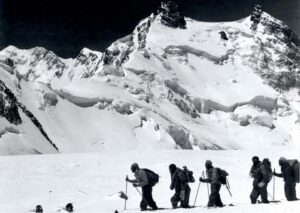Nestled in a valley between the three peaks of Trishul in the Indian Himalaya lies a small body of water. At 5,000m above sea level, Roopkund Lake is frozen for most of the year, and snow covers its shoreline. But for a few months every summer, the snow and ice melt away, revealing hundreds of skeletons in and around the lake.Thanks to these macabre remains, the lake has become known as Skeleton Lake. Since cold preserves the skeletons much of the year, most are in good condition. Some still have flesh attached. How they got there, and why there are so many, remains a mystery.
In 1942, a forest ranger stumbled across the site. He assumed that the bones belonged to Japanese soldiers who had tried to invade India. He reported what he had found, but the skeletons were then forgotten until the mid-1950s. Since then, interest and research on the mysterious lake have continued intermittently.

Photo: Shutterstock
Some skeletons are 800 years old
Carbon dating places some bones between 500 and 800 years old, while others are more recent. No other clues have turned up, prompting imaginations to run wild. Just how did so many skeletons end up at a lake that is a strenuous five to six-day trek from the nearest village?
Some Indian researchers suggested that the lake was a place where holy men committed ritual suicide. Another theory claimed that the skeletons were Indian soldiers from the 13th century, sent by the Sultan of Delhi to invade Tibet.
Some thought that they were Tibetan traders from the Silk Road who fell victim to an illness or the elements. Others said that the lake was an open-air grave where victims of an epidemic were taken to stop a virus from spreading. A popular theory is that the large group all died from a single catastrophe over 1,000 years ago.
The legend of Nanda Devi
Locals in the villages of Uttarakhand, below Roopkund, said that the answers lay in folk legends. Their villages lie along one of the most difficult and lengthy pilgrimage routes in India to honor Nanda Devi. The country’s second-highest mountain (7,816m), it is a manifestation of Parvati, a Hindu goddess.
The folk tale explains that hundreds of years ago, Nanda Devi visited a distant kingdom. Here, the king and queen treated her discourteously, and she put a curse on the kingdom. The king and queen tried to appease the goddess by embarking on a pilgrimage.
During the journey, the queen gave birth to a child, and the king brought with him dancers and luxuries. All this further angered Parvati. She thought that this corrupted her holy land and she created a hailstorm “as hard as iron”. It killed the king, his wife, and all their followers as they passed the lake.

Photo: Himadri Sinha Roy
Recent analyses of the skeletons suggest that all the current theories are incorrect. A 2019 study involving 16 institutions, and 28 authors from India, the U.S., and Germany genetically analyzed 38 bodies from the lake. The results led to more questions than answers.
First, the bodies were not from a single time period. Their DNA splits them into three clear groups. Twenty-three of the individuals had genetics similar to present-day South Asians, though they don’t belong to the same population, and their bones date from the 7th to 10th centuries.
The results shocked researchers
The remaining two groups of bones are much more contemporary, from the 17th to the 20th century. One individual had East Asian ancestry. The remaining 14 were eastern Mediterranean. Shocked by the results, the research team carried out dietary analyses on the bones to see if they supported the DNA results. They did.
No one can come up with a theory as to why hundreds of people from different time periods and ancestries all died at one small, obscure, out-of-the-way site. There are no weapons or trade goods nearby, nor is there evidence of an ancient bacterial pathogen. There is no known historical record of non-Indian people being in this remote part of the Himalaya at the times suggested by the data. The skeletons at the lake continue to confuse scientists and intrigue the public.

The trek to Skeleton lake. Photo: Shutterstock





